The concrete surface retarders market is expected to grow from USD 90.3 million in 2025 to USD 154.2 million by 2035, registering a 5.5% CAGR and generating an absolute dollar opportunity of USD 63.9 million. Growth is driven by increasing construction activity, particularly in infrastructure, commercial, and residential projects, where surface retarders are used to create textured concrete finishes, improve adhesion for overlays, and enhance aesthetic appeal. Demand is supported by innovations in chemical formulations that offer improved performance, durability, and environmental compliance. Peak-to-trough analysis highlights cyclical patterns in market demand over the forecast period.
Peaks are observed during periods of heightened construction activity, including urban infrastructure development, highway projects, and commercial building expansion, which drive increased adoption of concrete surface retarders. Conversely, troughs emerge during construction slowdowns caused by economic downturns, seasonal variations, or delays in public infrastructure investment. Regional variations further influence market cycles: North America and Europe exhibit moderate peaks due to mature construction industries, while Asia Pacific shows more pronounced peaks aligned with rapid urbanization, industrial projects, and large-scale infrastructure initiatives.
The market demonstrates resilience, with peaks balancing troughs to sustain a steady upward trajectory. The USD 63.9 million opportunity reflects both new construction projects and ongoing maintenance activities, ensuring consistent demand for concrete surface retarders across global markets from 2025 to 2035.

| Metric | Value |
|---|---|
| Concrete Surface Retarders Market Estimated Value in (2025 E) | USD 90.3 million |
| Concrete Surface Retarders Market Forecast Value in (2035 F) | USD 154.2 million |
| Forecast CAGR (2025 to 2035) | 5.5% |
The concrete surface retarders market is mainly driven by the construction and infrastructure sector, which accounts for approximately 50% of the market share, as these chemicals are used to create exposed aggregate finishes and control curing times. Precast concrete manufacturers contribute around 20%, applying retarders for decorative panels and structural elements. The commercial and residential building segment represents close to 15%, using surface retarders for aesthetic and functional concrete surfaces. Industrial construction accounts for roughly 10%, where retarders help manage curing in large-scale projects. The remaining 5% comes from specialty applications, including decorative landscaping and civil engineering projects requiring precise surface treatments.
The concrete surface retarders market is advancing through innovations in chemical formulations, application methods, and sustainability practices. New retarder chemicals are designed for faster, uniform performance, enabling controlled curing without compromising structural integrity. Spray and brush-on application techniques are becoming more popular, improving efficiency and reducing labor costs. Eco-friendly and low-VOC formulations are gaining attention to meet environmental standards. Integration with ready-mix concrete and precast operations is increasing adoption. Manufacturers are developing customizable solutions tailored to different concrete mixes and weather conditions. Strategic partnerships with construction companies and distributors are expanding market reach, while rising demand for decorative and architectural concrete is driving growth.
Increased urbanization and infrastructure development have created a higher demand for exposed aggregate finishes and non-slip surfaces in both public and private construction.
The market is also benefiting from the expanding use of decorative concrete in residential and commercial projects, where surface texture and visual appeal are critical. Additionally, stricter environmental regulations are encouraging the adoption of products with lower volatile organic compound emissions, boosting the use of more eco-friendly surface treatment options.
The ability of concrete surface retarders to deliver controlled setting times while preserving the concrete’s structural integrity is further contributing to their rising demand across varied construction segments. With advancements in formulation technologies and growing acceptance among contractors and architects, the market is expected to maintain a strong growth trajectory over the coming years.
The concrete surface retarders market is segmented by type, material, end-use, distribution channel, and geographic regions. By type, concrete surface retarders market is divided into Water based and Solvent based. In terms of material, concrete surface retarders market is classified into Organic agent and Inorganic agent.
Based on end-use, concrete surface retarders market is segmented into Residential and Commercial. By distribution channel, concrete surface retarders market is segmented into Direct and Indirect. Regionally, the concrete surface retarders industry is classified into North America, Latin America, Western Europe, Eastern Europe, Balkan & Baltic Countries, Russia & Belarus, Central Asia, East Asia, South Asia & Pacific, and the Middle East & Africa.

The water based segment is expected to account for 63.1% of the overall Concrete Surface Retarders market revenue in 2025, positioning it as the dominant type. This leadership is being supported by increasing demand for low-toxicity and easy-to-apply formulations in modern construction practices. Water based surface retarders are preferred due to their environmentally friendly composition and reduced health risks during application.
Their compatibility with green building certifications and compliance with air quality standards has accelerated their acceptance, particularly in residential and institutional projects. Improved performance in terms of surface finish, user safety, and application efficiency has contributed to the widespread preference for this type.
Contractors are increasingly opting for water-based solutions due to their ease of cleanup and minimal odor, which enhances usability on indoor and outdoor sites alike. The shift towards sustainable construction materials and regulatory encouragement for eco-friendly products are expected to sustain the growth of this segment well into the forecast period.
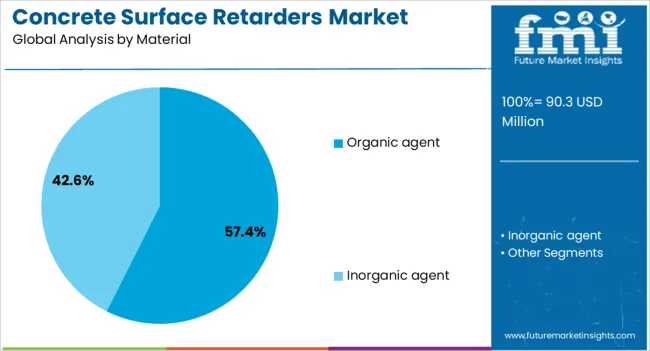
The organic agent segment is projected to represent 57.4% of the Concrete Surface Retarders market revenue share in 2025, emerging as the leading material type. This dominance is being driven by the superior chemical performance and consistency offered by organic retarders in controlling cement hydration on targeted surfaces. The segment's growth is being fueled by increased usage in applications requiring precision and uniform texture exposure.
Organic agents provide more predictable outcomes across varying weather conditions, making them highly reliable for contractors operating in diverse climates. These materials are also capable of delivering consistent surface profiles, which is particularly important in architectural concrete and exposed aggregate work.
With rising construction standards and demand for high-finish aesthetics, organic formulations are being chosen for their proven performance. As quality control and repeatability become more crucial in large-scale construction, the preference for organic agents is likely to expand further, reinforcing their strong market presence.
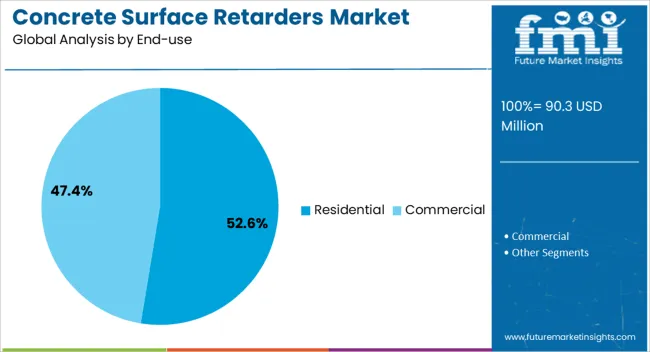
The residential segment is estimated to contribute 52.6% of the Concrete Surface Retarders market revenue in 2025, leading among end-use applications. This leadership is being attributed to the growing emphasis on decorative finishes, non-slip surfaces, and custom textures in modern housing designs. Residential construction has seen a notable rise in the use of exposed aggregate surfaces for driveways, patios, and walkways, driving demand for surface retarders that provide clean, textured finishes.
Homeowners and developers are increasingly focused on aesthetics and safety, prompting wider use of surface modification techniques that enhance durability while also improving visual appeal. Additionally, the rising adoption of stamped and decorative concrete in urban residential developments is supporting increased product usage.
With expanding housing projects and renovation activities worldwide, the residential sector remains a major driver of growth. The ease of application and compatibility of concrete surface retarders with existing residential construction practices continue to position this segment at the forefront of market demand.
The concrete surface retarders market is expanding due to increasing demand in architectural concrete, infrastructure, and decorative projects. Global revenue crossed USD 1.2 billion in 2024, with Asia Pacific holding 40% share led by China, India, and Japan due to large-scale urban construction and infrastructure projects. North America contributes 28%, driven by high-rise construction and precast concrete applications in the USA Europe represents 25%, led by Germany, UK, and France with growing architectural concrete adoption. Retarders for uniform exposure and enhanced surface texture dominate with 55% of sales, followed by liquid-form and powder-form variants. Improved aesthetics, durability, and application flexibility are driving adoption across commercial and infrastructure projects globally.
Architectural and decorative concrete applications account for 50% of global demand. Exposed aggregate, stamped, and textured surfaces contribute significantly, requiring precise retardation for aesthetic consistency. Asia Pacific leads with 40% share due to large urban developments in China, India, and Japan. North America contributes 28%, emphasizing high-rise and precast architectural concrete. Europe holds 25%, with demand in commercial and civic building projects. Liquid-form retarders dominate 60% of usage due to ease of application and uniform performance. Growth is supported by urban infrastructure expansion, landscaping, and decorative pavement projects. Rising demand for visually appealing and durable concrete surfaces continues to drive global adoption.
Advancements in concrete surface retarders include polymer-modified formulations, improved curing control, and environmental resistance. Modern retarders extend surface exposure time by 15–20% while maintaining concrete strength. Liquid polymers enhance uniformity, reduce streaking, and improve adhesion of surface treatments. Asia Pacific focuses on cost-efficient, high-performance retarders for mass construction. North America emphasizes precision chemical formulations for architectural and precast applications. Europe prioritizes eco-friendly retarders with low VOC content. These innovations improve surface aesthetics, workability, and long-term durability, supporting adoption in high-end architectural projects, public infrastructure, and decorative concrete globally.
Concrete surface retarders are increasingly used in infrastructure, bridges, highways, and precast concrete manufacturing. Infrastructure projects account for 35% of adoption due to enhanced surface texture and anti-slip properties. Precast concrete applications contribute 25%, improving finish consistency and reducing post-treatment labor. Asia Pacific leads with 40% share, driven by highway expansion and urban bridge construction. Europe contributes 25%, focusing on sustainable precast projects. North America accounts for 28%, emphasizing high-rise precast panels and public works. Growing infrastructure investments, decorative concrete demand, and precast construction adoption are driving global market growth.
Concrete surface retarders face challenges from high chemical costs and precise application needs. Polymer-based and specialty retarders cost 15–25% more than conventional chemical additives. Incorrect application can cause uneven surface exposure, reducing aesthetics and increasing post-treatment costs by 10–15%. Skilled labor and technical expertise are required for uniform performance, especially in large-scale and complex projects. Supply chain constraints for high-quality polymers and additives impact availability in Asia Pacific and Latin America. Manufacturers address these challenges through training programs, application guides, and ready-to-use formulations. Despite benefits in durability and aesthetics, cost intensity and expertise requirements remain key adoption barriers globally.
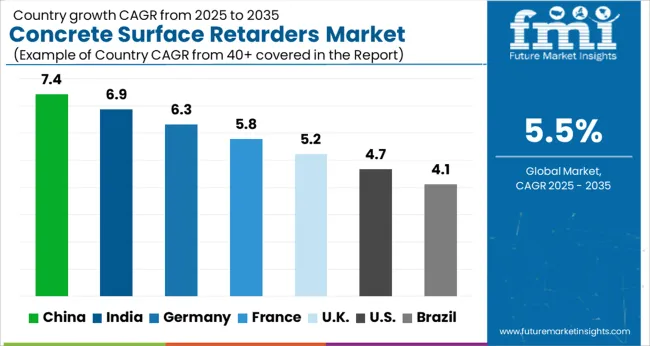
| Country | CAGR |
|---|---|
| China | 7.4% |
| India | 6.9% |
| Germany | 6.3% |
| France | 5.8% |
| UK | 5.2% |
| USA | 4.7% |
| Brazil | 4.1% |
In 2025, the concrete surface retarders market is projected to grow at a global CAGR of 5.5% through 2035, driven by rising construction activity, increasing demand for decorative and textured concrete, and adoption in commercial and infrastructure projects. China leads at 7.4%, 34.5% above the global benchmark, supported by BRICS-driven expansion in urban infrastructure, industrial construction, and large-scale building projects. India follows at 6.9%, 25.5% above the global average, reflecting growing residential and commercial construction, rising infrastructure development, and adoption of advanced concrete finishing techniques. Germany records 6.3%, 14.5% above the benchmark, shaped by OECD-backed innovations in high-performance retarders, architectural concrete applications, and premium construction standards. The United Kingdom posts 5.2%, 5.5% below the global rate, influenced by selective use in infrastructure upgrades, commercial projects, and specialty construction segments. The United States stands at 4.7%, 14.5% below the benchmark, with steady demand in industrial, residential, and niche decorative concrete applications. BRICS economies drive volume growth, OECD countries focus on quality, performance, and advanced construction methods, while ASEAN nations contribute through expanding infrastructure projects and commercial construction.
China concrete surface retarders market is expanding at a CAGR of 7.4%, above the global 5.5%, driven by rapid infrastructure projects and commercial construction activity. In 2024, demand increased by 8% in metropolitan areas including Shanghai, Beijing, and Guangzhou. Key players such as Sika, BASF, and Fosroc introduced advanced chemical formulations to enhance surface finishing and control setting time. Adoption is supported by large-scale urban construction, highway projects, and prefabricated concrete components. Companies are emphasizing high-performance retarders that improve surface quality while maintaining durability in varying climatic conditions.
India concrete surface retarders market is growing at a CAGR of 6.9%, above the global 5.5%, fueled by ongoing infrastructure development and commercial construction. In 2024, installations increased by 7% in regions including Delhi, Mumbai, and Bengaluru. Companies such as ACC, BASF, and Fosroc focused on improving chemical efficiency and durability for tropical conditions. Retarders are increasingly applied in bridges, flyovers, and large residential projects. Demand is also supported by modular construction practices requiring precise setting control and enhanced surface aesthetics.
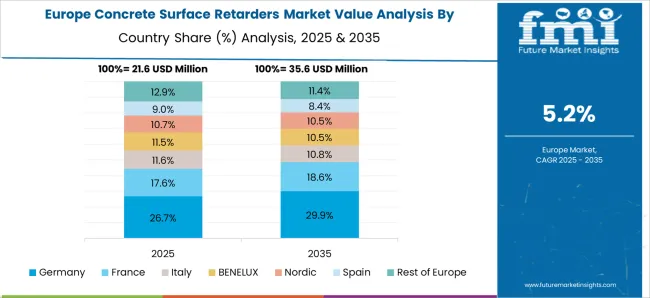
Germany concrete surface retarders market is growing at a CAGR of 6.3%, above the global 5.5%, supported by commercial and public infrastructure projects emphasizing high-quality finishes. In 2024, demand increased by 6%, mainly in Berlin, Munich, and Frankfurt. Companies including Sika, BASF, and MC-Bauchemie provided innovative retarders tailored for cold climate applications and precise surface texturing. Adoption is driven by urban development, public transport facilities, and sustainable construction methods that require controlled setting times and enhanced aesthetic quality.
United Kingdom concrete surface retarders market is increasing at a CAGR of 5.2%, slightly below the global 5.5%, with demand driven by urban redevelopment and commercial projects. In 2024, installations rose by 5%, concentrated in London, Manchester, and Birmingham. Key suppliers including Sika, Fosroc, and BASF introduced chemical retarders suitable for high-strength concrete and modern architectural designs. Demand is supported by bridge refurbishment projects and residential construction requiring precise surface control and uniform finishes.
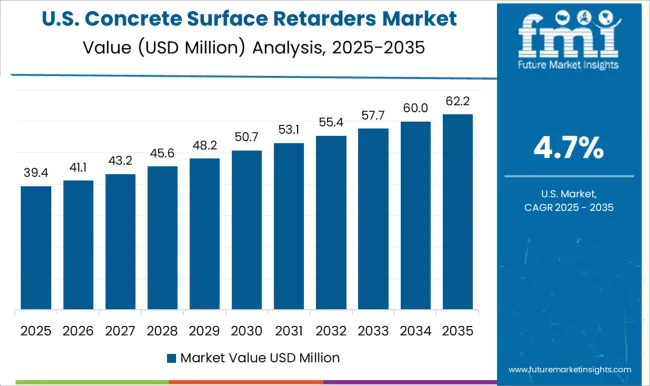
United States concrete surface retarders market is growing at a CAGR of 4.7%, below the global 5.5%, reflecting steady adoption in mature construction sectors. In 2024, installations rose by 5%, mainly in California, Texas, and New York. Companies such as BASF, Sika, and Euclid Chemicals introduced retarders tailored for highway, airport, and commercial building projects. Adoption focuses on improved surface aesthetics, controlled setting times, and durability under diverse environmental conditions. Demand is driven by public infrastructure upgrades and high-quality commercial construction.
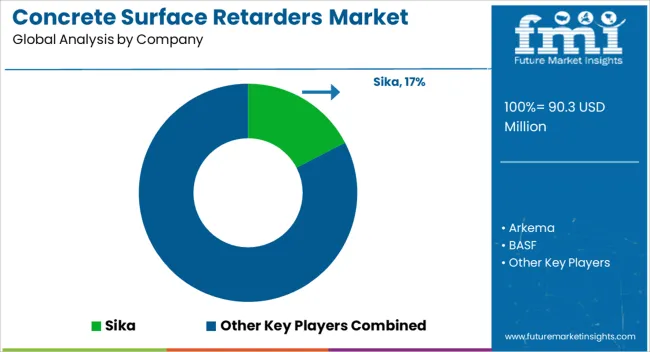
Competition in the concrete surface retarders market is being shaped by performance consistency, ease of application, and compatibility with diverse concrete formulations. Market positions are being maintained through certified chemical products, technical support, and distribution networks that ensure reliable supply for construction and precast projects. Sika is being represented with surface retarders designed for uniform exposure of aggregates and controlled setting. Arkema is being promoted with liquid and paste formulations structured for precision timing in surface finishing. BASF is being applied with concrete admixtures engineered for consistent retardation and workability. Cemex is being showcased with integrated surface treatment solutions tailored for large-scale construction projects. Chryso is being recognized with retarders formulated to improve surface aesthetics and reduce defects. Fosroc International is being advanced with products designed for both on-site and precast applications.
GCP Applied Technologies is being promoted with retarders optimized for performance in varied climate conditions. Koster Bauchemie is being applied with chemical solutions structured for reliable retardation and surface quality. LATICRETE International is being represented with admixtures designed for decorative concrete applications. Mapei is being highlighted with retarders engineered for high-performance concrete and architectural finishes. MBCC Group is being advanced with products optimized for workability and controlled setting. RPM International is being promoted with retarders structured for commercial and industrial concrete projects. Schlumberger is being applied with chemical solutions tailored for surface finishing efficiency. The Euclid Chemical Company is being represented with retarders designed for precise aggregate exposure. W. R. Grace is being showcased with admixtures engineered for uniform surface performance and durability. Strategies are being directed toward product enhancement, formulation optimization, and expansion of technical support and distribution networks. Research and development efforts are being allocated to improve setting control, surface uniformity, and ease of application.
| Item | Value |
|---|---|
| Quantitative Units | USD 90.3 Million |
| Type | Water based and Solvent based |
| Material | Organic agent and Inorganic agent |
| End-use | Residential and Commercial |
| Distribution Channel | Direct and Indirect |
| Regions Covered | North America, Europe, Asia-Pacific, Latin America, Middle East & Africa |
| Country Covered | United States, Canada, Germany, France, United Kingdom, China, Japan, India, Brazil, South Africa |
| Key Companies Profiled | Sika, Arkema, BASF, Cemex, Chryso, Fosroc International, GCP Applied Technologies, Koster Bauchemie, LATICRETE International, Mapei, MBCC Group, RPM International, Schlumberger, The Euclid Chemical Company, and W. R. Grace |
| Additional Attributes | Dollar sales by retarder type and end use, demand dynamics across construction, infrastructure, and precast applications, regional trends in architectural and decorative concrete, innovation in formulation and application methods, environmental impact of chemical use, and emerging use cases in exposed aggregate and textured concrete finishes. |
The global concrete surface retarders market is estimated to be valued at USD 90.3 million in 2025.
The market size for the concrete surface retarders market is projected to reach USD 154.2 million by 2035.
The concrete surface retarders market is expected to grow at a 5.5% CAGR between 2025 and 2035.
The key product types in concrete surface retarders market are water based and solvent based.
In terms of material, organic agent segment to command 57.4% share in the concrete surface retarders market in 2025.






Full Research Suite comprises of:
Market outlook & trends analysis
Interviews & case studies
Strategic recommendations
Vendor profiles & capabilities analysis
5-year forecasts
8 regions and 60+ country-level data splits
Market segment data splits
12 months of continuous data updates
DELIVERED AS:
PDF EXCEL ONLINE
Concrete Epoxy Repair Market Size and Share Forecast Outlook 2025 to 2035
Concrete Fiber Market Size and Share Forecast Outlook 2025 to 2035
Concrete Densification and Polishing Material Market Size and Share Forecast Outlook 2025 to 2035
Concrete Densifier Market Size and Share Forecast Outlook 2025 to 2035
Concrete Containing Polymer Market Size and Share Forecast Outlook 2025 to 2035
Concrete Bonding Agents Market Size and Share Forecast Outlook 2025 to 2035
Concrete Block Making Machines Market Size and Share Forecast Outlook 2025 to 2035
Concrete Air Entraining Agents Market Size and Share Forecast Outlook 2025 to 2035
Concrete Placing Booms Market Size and Share Forecast Outlook 2025 to 2035
Concrete Chain Saw Market Size and Share Forecast Outlook 2025 to 2035
Concrete Paving Equipment Market Size and Share Forecast Outlook 2025 to 2035
Concrete Admixture Market Growth - Trends & Forecast 2025 to 2035
Concrete Floor Coatings Market Growth - Trends & Forecast 2025 to 2035
Concrete Saw Market Growth - Trends & Forecast 2025 to 2035
Concrete Delivery Hose Market Growth – Trends & Forecast 2024-2034
Concrete Testers Market Growth – Trends & Forecast 2025-2035
Concrete Accelerators And Retarders Market Size and Share Forecast Outlook 2025 to 2035
Concrete Surface Treatment Chemicals Market Size and Share Forecast Outlook 2025 to 2035
Market Share Insights for Hollow Concrete Blocks Providers
Precast Concrete Market Size and Share Forecast Outlook 2025 to 2035

Thank you!
You will receive an email from our Business Development Manager. Please be sure to check your SPAM/JUNK folder too.
Chat With
MaRIA